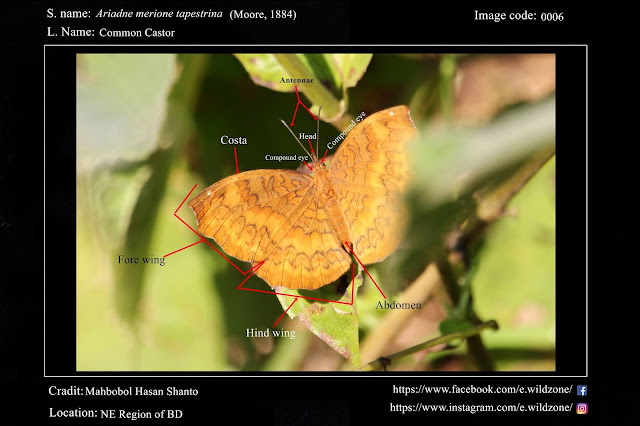Common Castor butterfly- Ariadne merione Cramer, 1777
Scientific Classification Of Common Castor:
Kingdom: Animalia
Phylum: Euarthropoda
Class: Inseca
Order: Lepidoptera
Family: Nymphalidae
Genus: Ariadne
Species: A. merione
Bio-data Of Common Castor butterfly:
Genus: Ariadne
Species: A. merione
Wingspan of Adult butterfly: 30-35
Larval Host Plant: Tragia involucrata (Euphorbiaceae)
Upperside Physical Description Of Common Castor:
In wet-seasons form the Ariadne merione is brownish ochraceous. Forewings and hindwings crossed by slender, somewhat obscure, very sinuous or zigzag dark basal. Two subbasal and discal lines disposed in pairs followed by a single or sometimes double, postdiscal and a single subterminal slender line. On the hindwing all these lines are more or less interrupted anteriorly which has a smooth unmarked uniform appearance from costa to subcostal vein and vein 5. There are an addition series of obscure spots between the postdiscal and subterminal markings on the forewing. Before the apex a small white subcostal spot present.
In dry-seasons form the Ariadne merione is much paler ground colour
Upperside: ground colour much paler, the transverse lines more distinctly in pairs, forming bands, the ground colour between each pair more dusky brown
Common Castor butterfly- Ariadne merione Cramer, Upper side (Ventral view)
Underwing Physical Description Of Common Castor:
From the underside the Ariadne merione butterfly is dark brownish. The transverse chestnut bands border are more diffuse. Female is similar to the male but the transverse chestnut bands border and more diffuse with a greater tendency to form bands. The postdiscal line always double. Forming a band traversed by a series of dark ochraceous spots in the interspaces, these lines and band continuously, not interrupted anteriorly on the hindwing as they are in the male. Antenna, head, thorex and abdomen brownish ochraceous. Sex-mark on the UNF but there is no sex-mark on the under UNH.
 |
| Common Castor butterfly- Ariadne merione Cramer, 1777 (Dorsal View) |
Mating Process Of Common Castor butterfly:
The mating system of Euarthropoda phylum is different from any other animals. Their companion finding system happens chemically. The female Euarthropoda spread pheromone in nature and the male find their own female species by their anatanea contention. The male can get the signal from 3km less or more. Thus they find their specimen. If the female accept the male they go on a short courtship flight. They may remain couple for an hour or more, sometimes overnight. The male passes a sperm packet to the female called spermatorphore. The sperm then fertilize each egg as it passes down the females egg-laying tube.
 |
| Common Castor butterfly- Ariadne merione Cramer, 1777 (Mating pair) |
 |
| Common Castor butterfly- Ariadne merione Cramer, 1777 (Mating ) |
Upperside external morphology of Common Castor butterfly:
These parts are the basic external morphological parts of a a Ariadne merione -Common Castor butterfly. Almost all butterfly contains these parts:
- Antenna: Like other butterflies the antenna of Ariadne merione, Common Castor butterfly is placed on the forehead. Both antennas are blackish brown in coloration. But at wet season form their antenna could be transform into silver color.
- Head: The head section contains four parts of a butterfly. The combination of these parts are known as head section. These are:
1. Compound eyes.
2. Antennas.
3. Labial palp.
4. Proboscis.
2. Antennas.
3. Labial palp.
4. Proboscis.
- Costa: Both upper forewings edge is known as costa. The Ariadne merione, Common castor butterfly contain a costal spot at the end of the wings. Costal color is also brown as well as the body color.
- Fore wings: Mainly a butterfly contains two pair or four wings. Fore wings are commonly known as fore wings. And the posterior wings are called as hind wings.
- Abdomen: As well as all kinds of animals and insects butterflies abdomen also work as a power house. Adult butterflies take nectar from flowers and minerals from mud. These minerals stored on their abdomen. Ariadne merione Common Castor butterflies abdomen color matches to the body color.

Underside external morphology of Common Castor butterfly:
The under wings color of Ariadne merione tapestrina - common castor butterfly is dark brown.And the costal white spot is also prominent.
- Costa: Under forewings edge is costa, similar place of the upper wings costa. The underside costa of Ariadne merione, Common castor butterfly is dark brown.
- Labial palp: The labial palp is like tongue. Because labial palp help a butterfly to taste food and also identify that what is eatable and what is not. Labial palp contain a pair of hairy mostache seems scaly appendages on the head of the butterfly. The palp is covered with sensory hair. The palps are different shape according to different families of butterflies.
- Proboscis: Directly proboscis work as a tongue. Butterflies take their minerals through the proboscis.
"A proboscis (/proʊˈbɒsɪs/ or /proʊˈbɒskɪs/) is an elongated appendage from the head of an animal, either a vertebrate or an invertebrate. In invertebrates, the term usually refers to tubular mouthparts used for feeding and sucking. In vertebrates, a proboscis is an elongated nose or snout." [wiki] - Cell: The central area of the wing surrounded by veins is called cell or the place where every vein is combined.
Behavior of Common castor butterfly:
Ariadne merione tapestrina- Common Castor butterfly flight very slow and like to take rest the same places. This butterfly comes back the same places again and again.
Local Distribution Of Common Castor:
The Ariadne merione widely distributed in Bangladesh. One can see this beauty in all seasons. Fairly it's more visited in rainy seasons.




0 Comments
Post a Comment